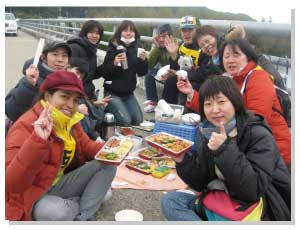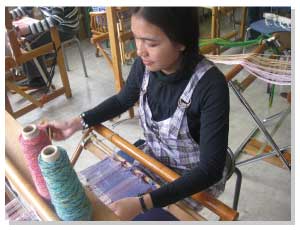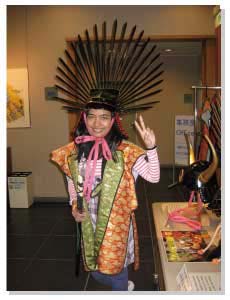- HOME
- Alumni News
- Amraroth Um (10th trainee)
- Amra's Final Report
Amra's Final Report
My Training in Japan
Japanese language training and swimming
The first three months I attended a Japanese class. It was really difficult for me, especially pronunciation. I tried to practice everyday, so I could pass the Japanese Language exam. Moreover, every Friday evening, I went swimming with other trainees. Before that I really did not know how people with disabilities could swim, so it was a very good experience to learn about the people with disabilities and sport activities. I enjoyed swimming so much.
Group training
During the group training I learned from many teachers a lot of basic knowledge related to disability which helped me to learn more about the life and movement of people with disabilities in Japan, including the independent living movement, leadership training and UN Convention on the Rights of Persons with Disabilities.
Home stay Program
During the New Year in Japan I went to Kagoshima for my home stay program. This was the first time for me to stay with a Japanese family. My host family, Miyuki san and Michie san had disabilities, so I started to learn about the culture and helper system of the people with disabilities in Japan. I would like to appreciate my host family for giving me the warm heart during this program.
Computer program Training
During my training I understood the advantage of having one’s own homepage. We can show information about ourselves, including our activities or the schedule when we go back to own country; everyone in the world can see these things from my homepage. Moreover I learned Microsoft Office, so now I can make and update a homepage and use the new Microsoft program by myself.
Ski Training
In my life I had never seen snow. During the training I went to Niigata where there was a lot of snow. It was also deeply cold. It is a great place more than words can describe and it was very interesting to ski with the ski teacher. When I fell down and hit my face against the skis, tears started to fail down on my cheeks, but the teacher said no problem, let go. More importantly, special devices enable people with disabilities to enjoy skiing very much.
Independent living Training
1. Center for Independent Living “Partner”
At Partner I spent about two weeks to learn about the independent living of people with disabilities. Also I learned about the history of Partner and the independent living program. I learned about how to negotiate with the government and about the movement of persons with disabilities in Japan. I cannot forget how we always cooked meals together and went to many interesting places during the training. Thank you Partner for giving me your warm heart, I will remember it forever.
2. Mainstream Association
I went to the Mainstream Association to learn more about independent living of people with disabilities. Mainstream Association is an independent living center with an important history where people tried very hard to establish the center. Every day I met teachers with different disabilities to learn more about the independent living concept such as peer counseling, independent living program and to stand in the streets to raise funds for 2000 Asia TRY in Taiwan. Thank you everybody for your warm heart and the goodbye party.
3. Human Care Association
As I learned more about the independent living movements at Human Care Association, my understanding on independent living finally became clear to me. I learned more about empowerment of people with disabilities; I also formulated a future plan, for when I am back in Cambodia.

Saori Training
I found Saori during the training program at Partner. Saori is a contemporary hand-weaving program founded in 1968 in Japan, by Misao Jo through which everyone could express themselves freely regardless of age, gender, disability or intellectual aptitude. Saori puts more importance to free expression and creativity rather than technical skills or regularity of the woven cloth. It always focuses on what only human beings can do without imitating machine-made products. No two weavers are alike, and it is very natural that every single cloth, freely woven by people with different personalities, is beautiful in different ways. This was the true art.
SAORI has also been welcomed as an art form for a variety of people including children, senior citizens and people with /without disabilities. Before coming to Japan I did not know the varieties of mental conditions or disabilities because in Cambodia we rarely saw these people participate in society so I want to introduce the Saori project in Cambodia so that it can help them join in the society just like anyone else. During the Saori training, I communicated with people with Down’s syndrome or intellectual disabilities through weaving Saori or other activities. I was very amazed that everyday in the morning I chose the color, thought about the design and by the evening I saw my beautiful weaving. Thank you everybody for the warm song at the end of the goodbye party.

DPI Training
At DPI Japan I learned about the meaning of the word “DPI”, their policy, activities and role of membership countries. I gave a presentation about the situation surrounding people with disabilities in Cambodia, and had an opportunity to compare it with that of Sweden.
How I changed after the training
Before I came to Japan, I did not know about the culture, movement or the education system for people with disabilities. Through the training I understood the meaning of all these words. Moreover, until then I had given up many opportunities because I thought that I was a disabled person, but now things changed..I was especially surprised because I had seen people with intellectual disabilities or Down’s syndrome working at SAORI. Before I came to Japan I had many purposes but after the training my goals became clearer; I want to promote the rights of mental and syndrome people with disabilities.

My dream when I go back Cambodia
I want to replicate the Saori project when I go back home. If this project can be done in Cambodia people with physical and intellectual disabilities can join the society through the Saori project. Below are some plans:
The Saori director said that he and his group would come to Cambodia in December 2009 or January 2010 to teach people with disabilities how to do the Saori weaving and how to gather students.
When I go back to Cambodia, Saori’s director will introduce me to the Ambassador of the Japanese Embassy in Cambodia, so that I can present the story of Saori Foundation to him. Myself and people with disabilities will try hard to work together and share the concept of independent living of people with disabilities.
Gratitude
Human rights should be guaranteed to every human being, and are a foundation for “the Society for All.” I would like to initiate activities to promote the rights of people with disabilities in Cambodia through the Saori project which I had found in Japan especially for people with intellectual disabilities or with Down’s syndrome.
I would like to say special thanks to the Duskin Ainowa Foundation which gave me the chance to fully accomplish my training goal in Japan. Also my thanks go to JSRPD and everybody in all the training places who always worked so hard and offered their warm hearts to me for the 10 months. Lastly, I hope strongly that this program will become the driving force to change the welfare system for persons with disabilities in the Asian and Pacific countries. Thank you very much.




